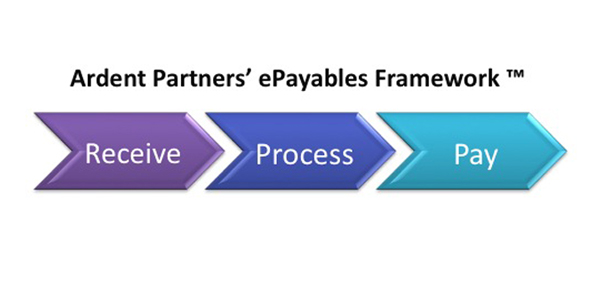Ardent Partners defines ePayables as the solutions and services that automate all or part of the three phases of the accounts payable (“AP”) process, including invoice receipt, invoice processing, and vendor payments. Ardent Partners developed its ePayables Framework to be used by AP and finance professionals to understand the different types of technology providers, and help improve the various operational components of the function. It was designed with the goal of helping AP departments improve their processes by segmenting them into smaller, more manageable pieces. This should (ideally) make it easier for AP teams to establish a clearer perspective on the current state of their operation, and find the areas that need improvement. The three major phases of the ePayables Framework are broken down as such:
- Receive – How invoices are received.
- Process – How Invoices are validated.
- Pay – How payments are scheduled and executed.
While the Framework divides the AP function into three phases, we should clarify that these are not completely separate stages, but rather sections of the whole operation. When a change occurs in one phase there is often a direct impact on the others. But segmenting the AP process into separate phases should hopefully help AP departments establish a clearer view on the current state of their operation. Having a better understanding into the activities within each phase will help to set standard operating procedures and also help determine best practices.
The AP process typically begins with the receipt of an invoice. The “Receive” phase includes the different methods that AP organizations handle the invoice submissions from suppliers and receipt. There are multiple formats in which organizations receive invoices (paper, fax, email, eInvoices, EDI, etc). As a result, solution providers that offer products that automate the ‘Receive’ portion of the AP process often differ in their approach.
Once the invoice is received, it is validated, matched (e.g., two- or three-way matching) and appropriately routed for approval. The “Process” phase handles the processing and workflow of the invoice. It also takes care of the validation. The first two segments include some of the broadly adopted solutions like scan, capture, and workflow solutions, eInvoicing solutions, and self-service supplier portals. It is the sub-steps that can vary depending on different factors such as company size, industry, and geography. These steps can also vary depending on organizational maturity and the level of automation that is already in place. Invoices that pass certain pre-configured matching rules (set by the client) can be processed straight-through without human intervention and passed directly into the ERP for payment, thereby leaving the AP staff to manage exceptions and errors.
The “Pay” phase includes both the scheduling and execution of vendor payments, and covers the last phase of the AP process. This category is comprised of electronic payment solutions providers as well as certain banks that have electronic payment solutions and card solutions. Some of these providers offer a wide range of payment options from check printing and mailing, ACH, Wire/Swift or cards with the aim of migrating their customers off paper checks. The use of ePayments solutions (payments made electronically by ACH, wire transfer, commercial cards, etc.,) or business/payment networks that provide B2B commerce platforms, allows users to transact and collaborate with suppliers directly.
Once current-state processes are captured, it should be much easier for AP groups to measure their key performance and operational metrics. This can include invoice volumes by segment, metrics around invoice accuracy, and performance (accuracy and timing) within each phase. The Ardent framework can then be used to determine which category of solution provider to investigate further. For example, a company that currently processes its paper invoices through its ERP system may determine that a scan and capture solution is appropriate for their needs as it allows them to receive scanned and captured data that is validated and matched against data from the ERP system and then passed back into the ERP system for approval and payment. It takes time and effort to build a business case for investments in automation, but having an understanding of the framework of the AP function will put your department on the right path towards a transformation project.
RELATED ARTICLES:
Download the State of ePayables 2018 Report Today!
The State of ePayables 2018: How Valuable is Your AP Team to the Greater Organization?
The State of ePayables 2018: Leveraging Technology in AP – 4 Steps to Take Now
The State of ePayables 2018: 3 Things AP Can Do to Be More Strategic







Comments are closed.